Banana: Insect and Mite Management
Banana: Insect and Mite Management
Banana rhizome weevil
Biology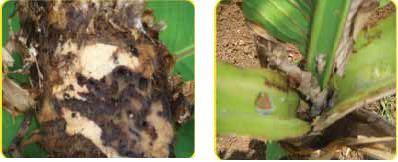 Egg: Eggs are laid singly, white in colour present on the upper part of rhizome.
Egg: Eggs are laid singly, white in colour present on the upper part of rhizome.- Grub: Grub is apodous, yellowish white with red head.
- Pupa: Pupa is white in colour, occur in inside the corm and tunneling.
- Adult: Adult is dark weevil, newly emerged weevil is red brown.
- Grubs bore into the rhizome and cause death of the plant. Presence of dark coloured tunnels in the rhizomes and withering of outer leaves.
- Weevils hide under debris or in the soil around banana plants during the day and are active at night
Banana stem weevil
Biology- Egg: Eggs are laid at random on cut ends of pseudostem, yellowish-white, cylindrical in shape.
- Grub: Grubs are apodous, creamy white with dark brown head.
- Pupa: Pupa is pale yellow colour, fibrous cocoon formed inside the tunneling on the periphery.
- Adult: Adults are robust, reddish brown and black.
 Grub bore into pseudostem making tunnels.
Grub bore into pseudostem making tunnels.- Tunneled part decomposes and pseudostem becomes weak.
- They also cut holes on outer surface later blackened mass comes out from the bore hole.
- Wilting of the plant.
- Infestation of the weevil normally starts in 5 month old plants.
Banana leaf eating caterpillar
Biology
It is found throughout the tropical and sub-tropical parts of the world, wide spread in India. Besides tobacco, it feeds on cotton, castor, groundnut, tomato, cabbage and various other cruciferous crops.
- Egg: Female lays about 300 eggs in clusters. The eggs are covered over by brown hairs and they hatch in about 3-5 days.
- Larva: Caterpillar measures 35-40 mm in length, when full grown. It is velvety, black with yellowish – green dorsal stripes and lateral white bands with incomplete ring – like dark band on anterior and posterior end of the body. It passes through 6 instars. Larval stage lasts 15-30 days.
- Pupa: Pupation takes place inside the soil, pupal stage lasts 7-15 days.
- Adult:
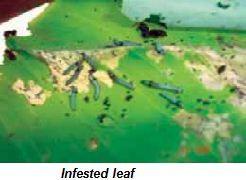 Moth is medium sized and stout bodied with forewings pale grey to dark brown in colour having wavy white crisscross markings. Hind wings are whitish with brown patches along the margin of wing. Pest breeds throughout the year. Moths are active at night. Adults live for 7-10 days. Total life cycle takes 32-60 days. There are eight generations in a year.
Moth is medium sized and stout bodied with forewings pale grey to dark brown in colour having wavy white crisscross markings. Hind wings are whitish with brown patches along the margin of wing. Pest breeds throughout the year. Moths are active at night. Adults live for 7-10 days. Total life cycle takes 32-60 days. There are eight generations in a year.
- Young larvae feed by scrapping the leaves from ventral surface
- Later on feed voraciously at night on the foliage
Banana aphid
Biology- Nymph :
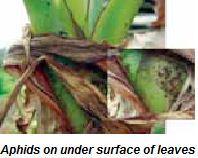 Oval or slightly elongated, reddish brown with six segmented antennae
Oval or slightly elongated, reddish brown with six segmented antennae - Adult:Small to medium sized aphids, shiny, reddish to dark brown or almost black. They have six segmented antennae and prominent dark veins. Adults start producing young one day after reaching maturity. They can give birth to 4 aphids per day with an average production of 14 off spring per female.
- Leaves are bunched into a rosette appearance.
- Leaf margins are wavy and upward rolling.
- Do not produce bunches.
- It is vector of bunchy top disease.
- Seen in colonies on leaf axils and pseudostem.
Rust thrips
Biology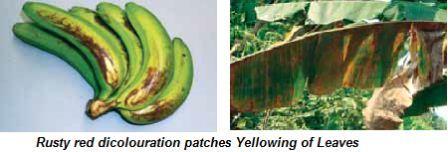 Egg: Eggs are not visible to the naked eye. Eggs are laid just below the fruit or pseudostem surface. In summer, eggs hatch in about eight days
Egg: Eggs are not visible to the naked eye. Eggs are laid just below the fruit or pseudostem surface. In summer, eggs hatch in about eight days- Larva: The wingless creamy white larvae are smaller but have the same shape as the adult. The larval period lasts about 8-10 days.
- Pupa: Pupae are white, 1 mm in length, similar to the larvae and can crawl. The pupal stage lasts 7-10 days
- Adult: The adult is slender, 1.5 mm long, creamy yellow to golden brown with delicate feathery wings.
- The early symptoms appear as water-soaked smoky areas where the colonies congregate to feed and oviposit between touching or adjacent fruit.
- These areas then develop the typical rusty-red to dark brown-black discolouration.
- Further rusty growth of the fruit and yellowing of leaves.
Lacewing bug
Biology- Small, whitish lacewing bug found in colonies on the foliage
- Causing a sickly and spotted appearance of the plant. The foliage of infested plants turns pale or yellow and dries up.
- The pest infestation is more common during the post monsoon period especially in drier regions of the country.

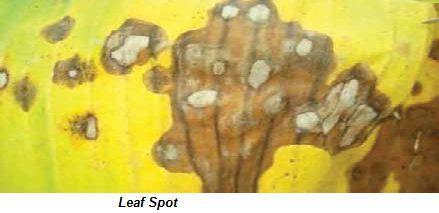
Banana scab moth
Biology The moth is small (25 mm wingspan) tan to light brown with small black spots on the wings.
The moth is small (25 mm wingspan) tan to light brown with small black spots on the wings.- The flattened eggs are laid in clusters ranging from a few to 30 eggs. The eggs resemble shiny overlapping fish scales.
- The yellow to orange larvae grow to about 25 mm before pupating.
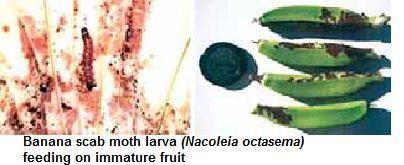 Larval feeding causes superficial scarring on young fruit. Damaged areas form a black callous, rendering the fruit unmarketable.
Larval feeding causes superficial scarring on young fruit. Damaged areas form a black callous, rendering the fruit unmarketable.- Feeding is generally confined to the curve of the fruit adjacent to the bunch stalk and between the fingers. Damage ceases after the hand lifts. Mature larvae can be found under the bracts enclosing the male flower or ‘bell’.
- This pest is most active during the hot wet summer months but sudden outbreaks can occur throughout the year in some localities.
- Damage occurs progressively as the hands lift and increases in severity towards the lower hands.
Hard scale
Biology- Egg: Eggs are laid beneath the scale. Adult females shrink in size as they lay their eggs. The female rotates as it deposits eggs so that eggs are arranged in concentric circles around the females. Eggs are laid in batches of 3 or 4 at a time. 65 to 110 eggs were laid by female. The eggs are white when first laid and turn yellow after a few days.
- Nymph: The larvae, called crawlers, have well-developed legs and antennae and a pair of bristles at the tip of the abdomen. The free living stage lasts from 2 to 48 hours, but usually does not exceed 12 hours. After the larvae have attached themselves to the leaf, they go through a period of rapid growth for 7-11 days before the first molt. The second larval stage lasts for 5-8 days for males and 8-10 days for females.
- Pupa: The male pupal period lasts for 4-6 days. Females continue to grow after their second molt for 8-9 days and do not change in body shape. When the female stops growing, she begins to lay eggs and is then considered an adult.
- Adult:
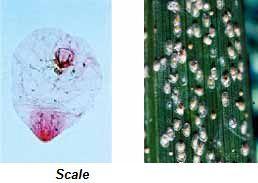 The adult female is orange-yellow semitransparent, circular in shape and approximately 1/12 inch in diameter. Females produce an average of 90 eggs throughout her lifetime. The adult male does not feed and is short lived. Reproduction primarily occurs through parthenogenesis, or reproduction without fertilization, in which females are able to produce both male and female progenies. Occasionally a female may lay eggs that produce only male scales.
The adult female is orange-yellow semitransparent, circular in shape and approximately 1/12 inch in diameter. Females produce an average of 90 eggs throughout her lifetime. The adult male does not feed and is short lived. Reproduction primarily occurs through parthenogenesis, or reproduction without fertilization, in which females are able to produce both male and female progenies. Occasionally a female may lay eggs that produce only male scales.
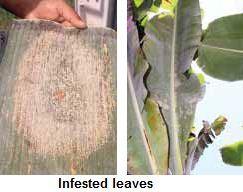 Grubs bore into the rhizome and cause death of the plant.
Grubs bore into the rhizome and cause death of the plant.- Presence of dark coloured tunnels in the rhizomes.
- Death of unopened pipe, withering of outer leaves
IPM for Banana
To know the IPM practices for Banana, click here.
Source: NIPHM and Directorate of Plant Protection, Quarantine & Storage
Last Modified : 2/13/2020
© C–DAC.All content appearing on the vikaspedia portal is through collaborative effort of vikaspedia and its partners.We encourage you to use and share the content in a respectful and fair manner. Please leave all source links intact and adhere to applicable copyright and intellectual property guidelines and laws.
RELATED ITEMS
Banana: Diseases and Symptoms
This topic covers the Information related to Disea...
Nutritional Deficiencies/Disorders of Banana
This topic covers the information related to Nutri...
Banana pests management in Mizoram
Technologies develope by ICAR in managing the pest...
Banana: Natural Enemies
Natural enemies of Banana insect pests are covered...
